Financial Accounting: Challenges and complexities of Impairment Loss
VerifiedAdded on 2022/09/18
|7
|1022
|23
Report
AI Summary
This report delves into the complexities and challenges associated with accounting for impairment loss, a crucial aspect of financial statement preparation and presentation. It examines the difficulties companies face in accurately calculating and reporting impairment losses on fixed assets and cash-generating units, as outlined by AASB 136. The report highlights challenges such as the accurate calculation of impairment loss, complexities in accounting treatments, and the gray areas between impairment loss and gain treatments. It references the Australian Securities and Investments Commission (ASIC) and relevant literature to provide a comprehensive understanding of the topic. The study emphasizes the need for careful management of assumptions and the impact of potential misjudgments on impairment calculations. The report also acknowledges the multi-dimensional nature of these challenges, emphasizing the importance of accurate financial reporting.
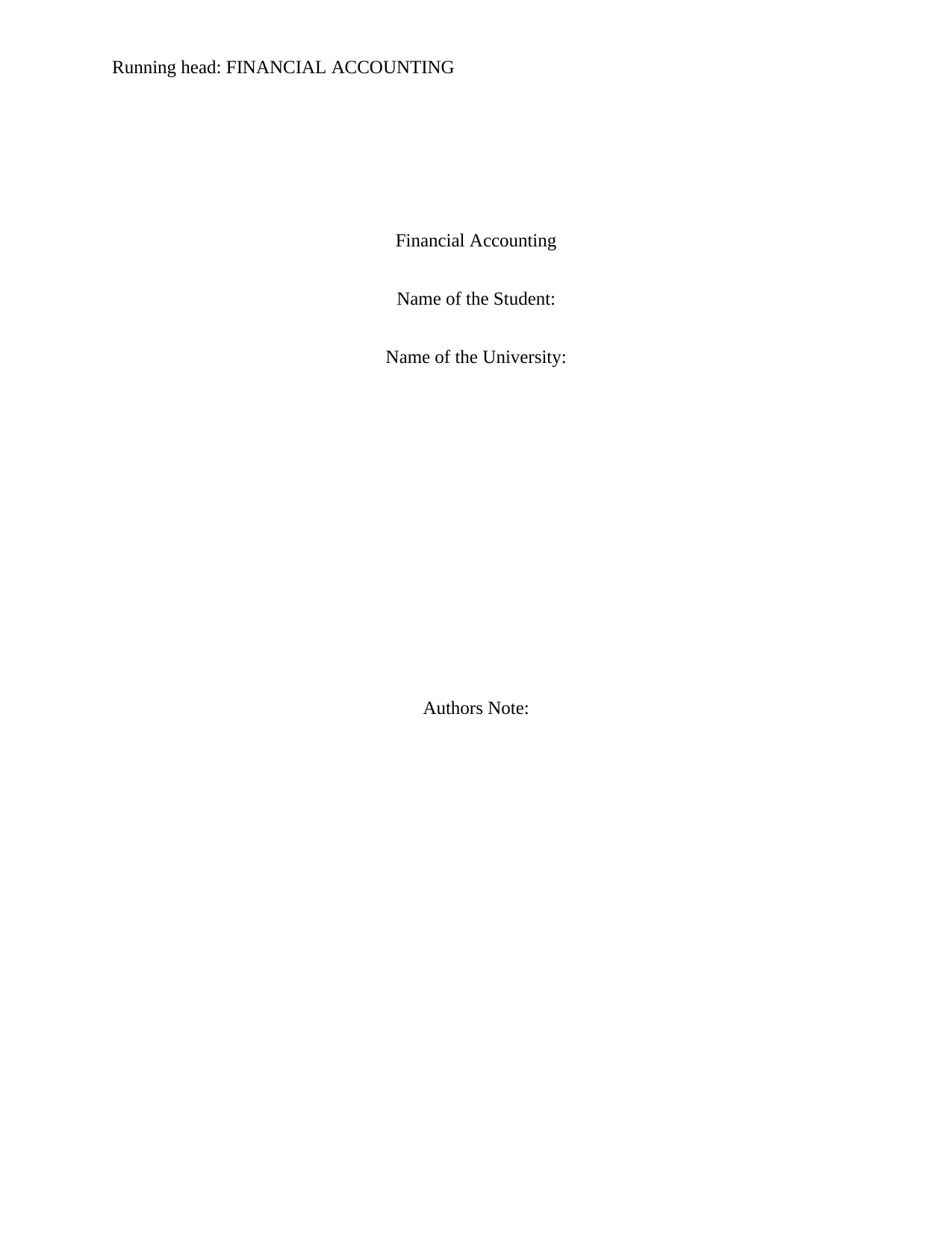
Running head: FINANCIAL ACCOUNTING
Financial Accounting
Name of the Student:
Name of the University:
Authors Note:
Financial Accounting
Name of the Student:
Name of the University:
Authors Note:
Paraphrase This Document
Need a fresh take? Get an instant paraphrase of this document with our AI Paraphraser
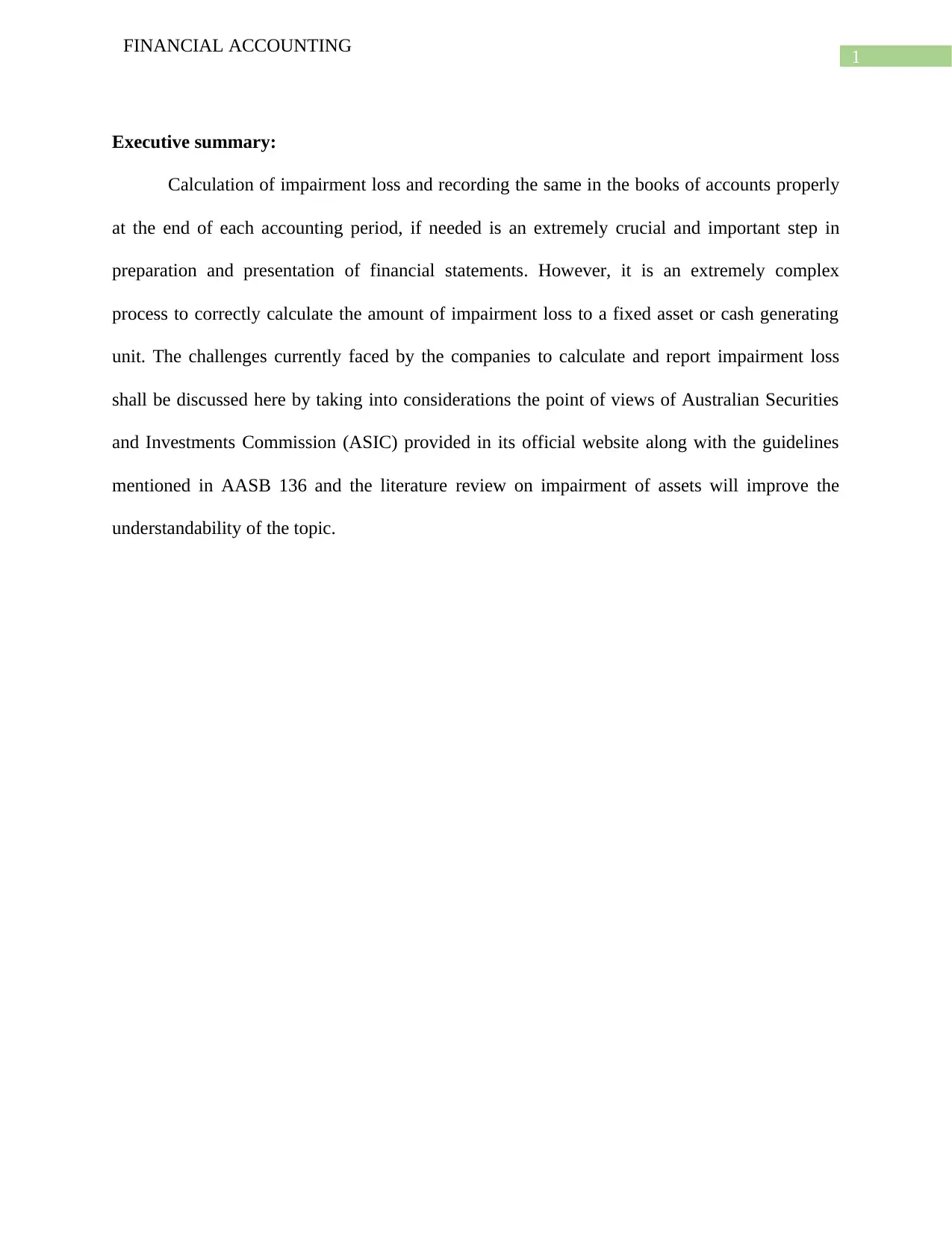
1
FINANCIAL ACCOUNTING
Executive summary:
Calculation of impairment loss and recording the same in the books of accounts properly
at the end of each accounting period, if needed is an extremely crucial and important step in
preparation and presentation of financial statements. However, it is an extremely complex
process to correctly calculate the amount of impairment loss to a fixed asset or cash generating
unit. The challenges currently faced by the companies to calculate and report impairment loss
shall be discussed here by taking into considerations the point of views of Australian Securities
and Investments Commission (ASIC) provided in its official website along with the guidelines
mentioned in AASB 136 and the literature review on impairment of assets will improve the
understandability of the topic.
FINANCIAL ACCOUNTING
Executive summary:
Calculation of impairment loss and recording the same in the books of accounts properly
at the end of each accounting period, if needed is an extremely crucial and important step in
preparation and presentation of financial statements. However, it is an extremely complex
process to correctly calculate the amount of impairment loss to a fixed asset or cash generating
unit. The challenges currently faced by the companies to calculate and report impairment loss
shall be discussed here by taking into considerations the point of views of Australian Securities
and Investments Commission (ASIC) provided in its official website along with the guidelines
mentioned in AASB 136 and the literature review on impairment of assets will improve the
understandability of the topic.
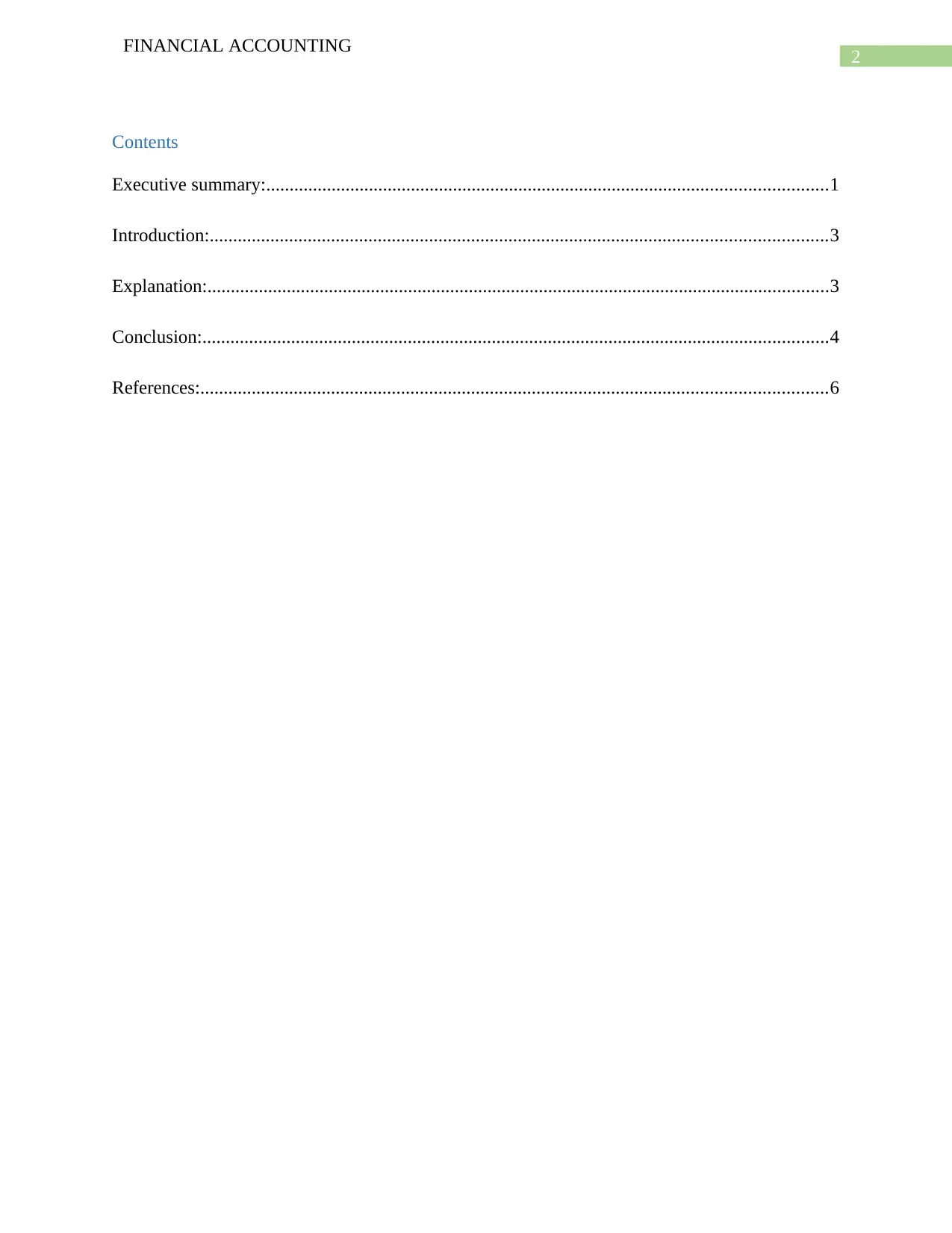
2
FINANCIAL ACCOUNTING
Contents
Executive summary:........................................................................................................................1
Introduction:....................................................................................................................................3
Explanation:.....................................................................................................................................3
Conclusion:......................................................................................................................................4
References:......................................................................................................................................6
FINANCIAL ACCOUNTING
Contents
Executive summary:........................................................................................................................1
Introduction:....................................................................................................................................3
Explanation:.....................................................................................................................................3
Conclusion:......................................................................................................................................4
References:......................................................................................................................................6
⊘ This is a preview!⊘
Do you want full access?
Subscribe today to unlock all pages.

Trusted by 1+ million students worldwide
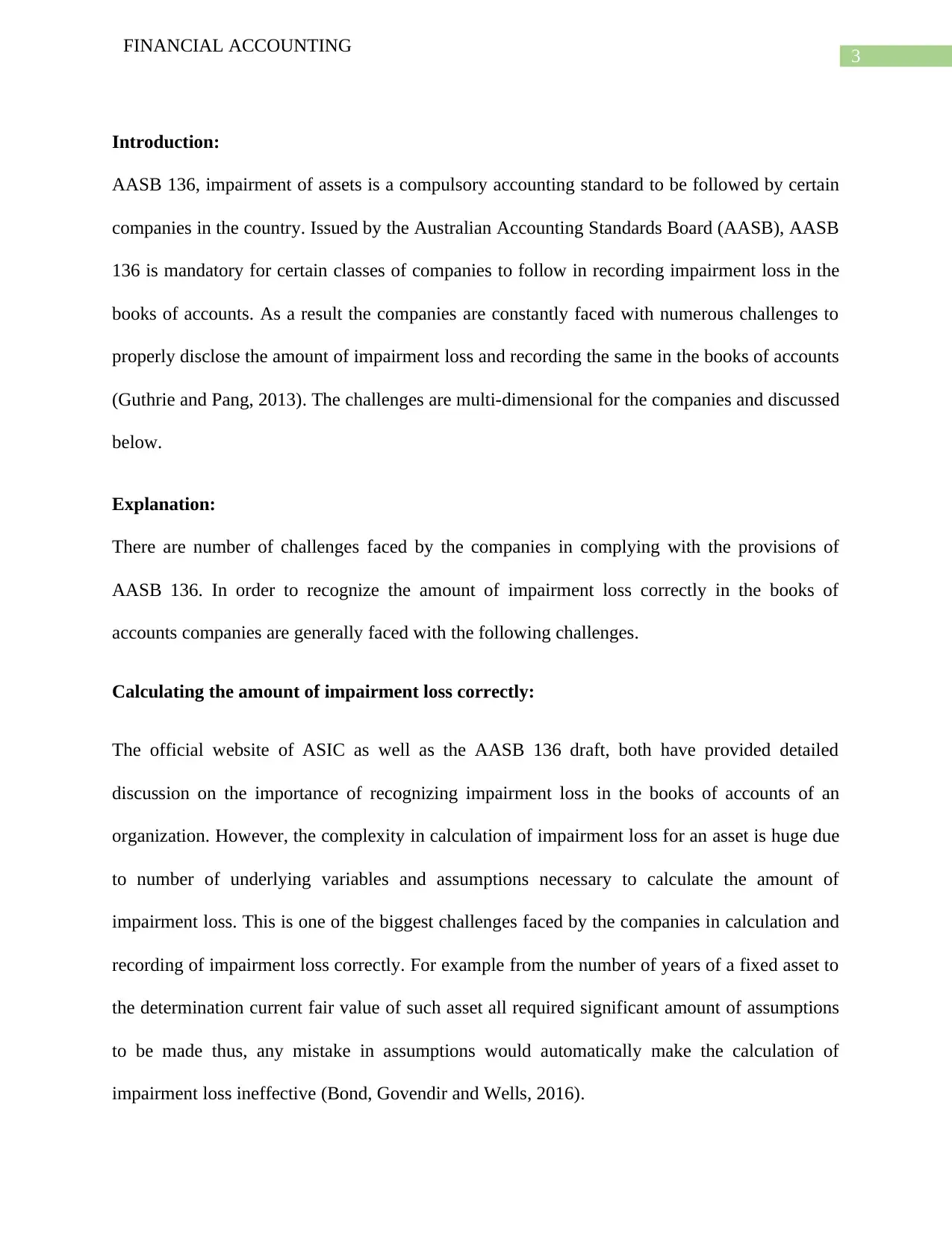
3
FINANCIAL ACCOUNTING
Introduction:
AASB 136, impairment of assets is a compulsory accounting standard to be followed by certain
companies in the country. Issued by the Australian Accounting Standards Board (AASB), AASB
136 is mandatory for certain classes of companies to follow in recording impairment loss in the
books of accounts. As a result the companies are constantly faced with numerous challenges to
properly disclose the amount of impairment loss and recording the same in the books of accounts
(Guthrie and Pang, 2013). The challenges are multi-dimensional for the companies and discussed
below.
Explanation:
There are number of challenges faced by the companies in complying with the provisions of
AASB 136. In order to recognize the amount of impairment loss correctly in the books of
accounts companies are generally faced with the following challenges.
Calculating the amount of impairment loss correctly:
The official website of ASIC as well as the AASB 136 draft, both have provided detailed
discussion on the importance of recognizing impairment loss in the books of accounts of an
organization. However, the complexity in calculation of impairment loss for an asset is huge due
to number of underlying variables and assumptions necessary to calculate the amount of
impairment loss. This is one of the biggest challenges faced by the companies in calculation and
recording of impairment loss correctly. For example from the number of years of a fixed asset to
the determination current fair value of such asset all required significant amount of assumptions
to be made thus, any mistake in assumptions would automatically make the calculation of
impairment loss ineffective (Bond, Govendir and Wells, 2016).
FINANCIAL ACCOUNTING
Introduction:
AASB 136, impairment of assets is a compulsory accounting standard to be followed by certain
companies in the country. Issued by the Australian Accounting Standards Board (AASB), AASB
136 is mandatory for certain classes of companies to follow in recording impairment loss in the
books of accounts. As a result the companies are constantly faced with numerous challenges to
properly disclose the amount of impairment loss and recording the same in the books of accounts
(Guthrie and Pang, 2013). The challenges are multi-dimensional for the companies and discussed
below.
Explanation:
There are number of challenges faced by the companies in complying with the provisions of
AASB 136. In order to recognize the amount of impairment loss correctly in the books of
accounts companies are generally faced with the following challenges.
Calculating the amount of impairment loss correctly:
The official website of ASIC as well as the AASB 136 draft, both have provided detailed
discussion on the importance of recognizing impairment loss in the books of accounts of an
organization. However, the complexity in calculation of impairment loss for an asset is huge due
to number of underlying variables and assumptions necessary to calculate the amount of
impairment loss. This is one of the biggest challenges faced by the companies in calculation and
recording of impairment loss correctly. For example from the number of years of a fixed asset to
the determination current fair value of such asset all required significant amount of assumptions
to be made thus, any mistake in assumptions would automatically make the calculation of
impairment loss ineffective (Bond, Govendir and Wells, 2016).
Paraphrase This Document
Need a fresh take? Get an instant paraphrase of this document with our AI Paraphraser
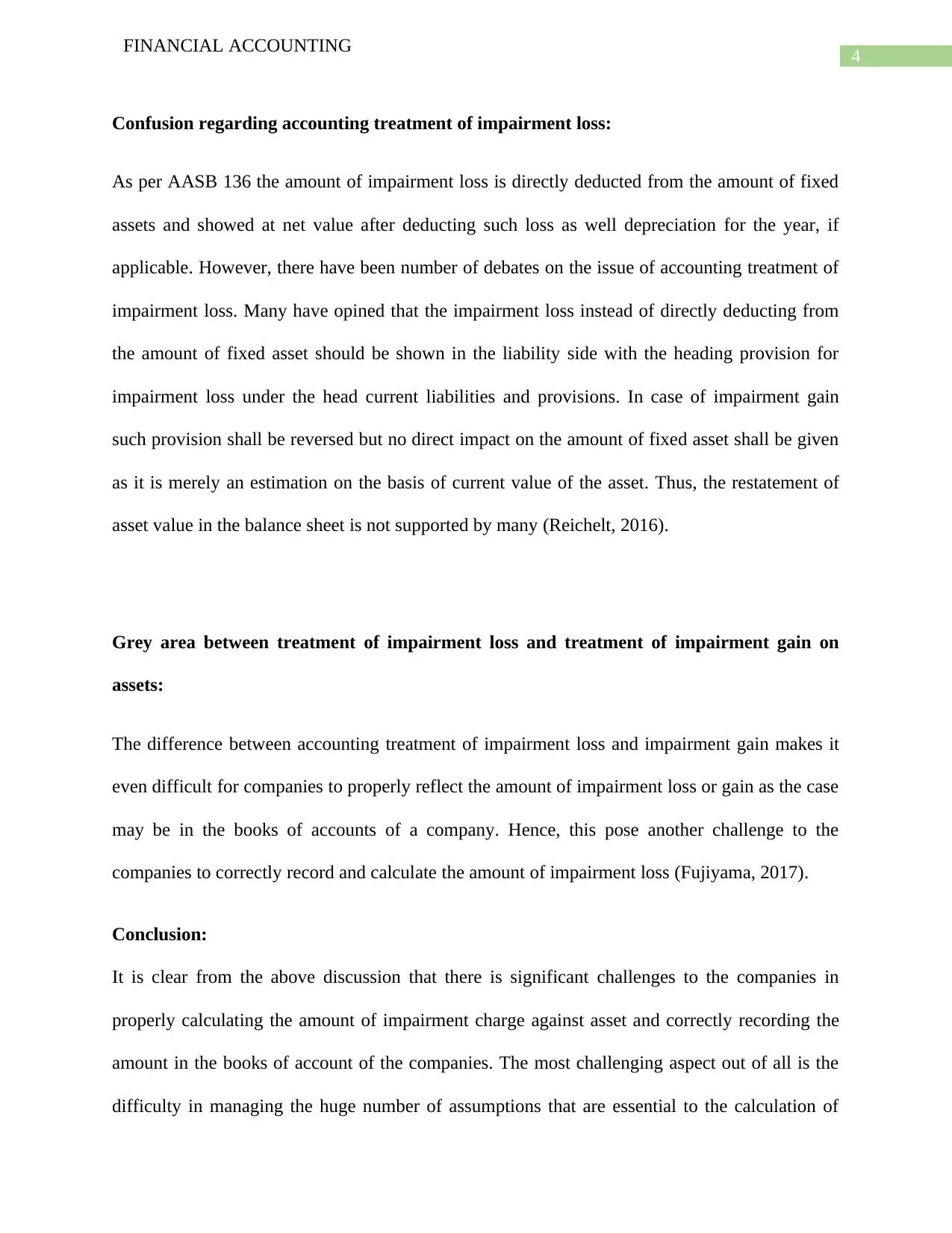
4
FINANCIAL ACCOUNTING
Confusion regarding accounting treatment of impairment loss:
As per AASB 136 the amount of impairment loss is directly deducted from the amount of fixed
assets and showed at net value after deducting such loss as well depreciation for the year, if
applicable. However, there have been number of debates on the issue of accounting treatment of
impairment loss. Many have opined that the impairment loss instead of directly deducting from
the amount of fixed asset should be shown in the liability side with the heading provision for
impairment loss under the head current liabilities and provisions. In case of impairment gain
such provision shall be reversed but no direct impact on the amount of fixed asset shall be given
as it is merely an estimation on the basis of current value of the asset. Thus, the restatement of
asset value in the balance sheet is not supported by many (Reichelt, 2016).
Grey area between treatment of impairment loss and treatment of impairment gain on
assets:
The difference between accounting treatment of impairment loss and impairment gain makes it
even difficult for companies to properly reflect the amount of impairment loss or gain as the case
may be in the books of accounts of a company. Hence, this pose another challenge to the
companies to correctly record and calculate the amount of impairment loss (Fujiyama, 2017).
Conclusion:
It is clear from the above discussion that there is significant challenges to the companies in
properly calculating the amount of impairment charge against asset and correctly recording the
amount in the books of account of the companies. The most challenging aspect out of all is the
difficulty in managing the huge number of assumptions that are essential to the calculation of
FINANCIAL ACCOUNTING
Confusion regarding accounting treatment of impairment loss:
As per AASB 136 the amount of impairment loss is directly deducted from the amount of fixed
assets and showed at net value after deducting such loss as well depreciation for the year, if
applicable. However, there have been number of debates on the issue of accounting treatment of
impairment loss. Many have opined that the impairment loss instead of directly deducting from
the amount of fixed asset should be shown in the liability side with the heading provision for
impairment loss under the head current liabilities and provisions. In case of impairment gain
such provision shall be reversed but no direct impact on the amount of fixed asset shall be given
as it is merely an estimation on the basis of current value of the asset. Thus, the restatement of
asset value in the balance sheet is not supported by many (Reichelt, 2016).
Grey area between treatment of impairment loss and treatment of impairment gain on
assets:
The difference between accounting treatment of impairment loss and impairment gain makes it
even difficult for companies to properly reflect the amount of impairment loss or gain as the case
may be in the books of accounts of a company. Hence, this pose another challenge to the
companies to correctly record and calculate the amount of impairment loss (Fujiyama, 2017).
Conclusion:
It is clear from the above discussion that there is significant challenges to the companies in
properly calculating the amount of impairment charge against asset and correctly recording the
amount in the books of account of the companies. The most challenging aspect out of all is the
difficulty in managing the huge number of assumptions that are essential to the calculation of
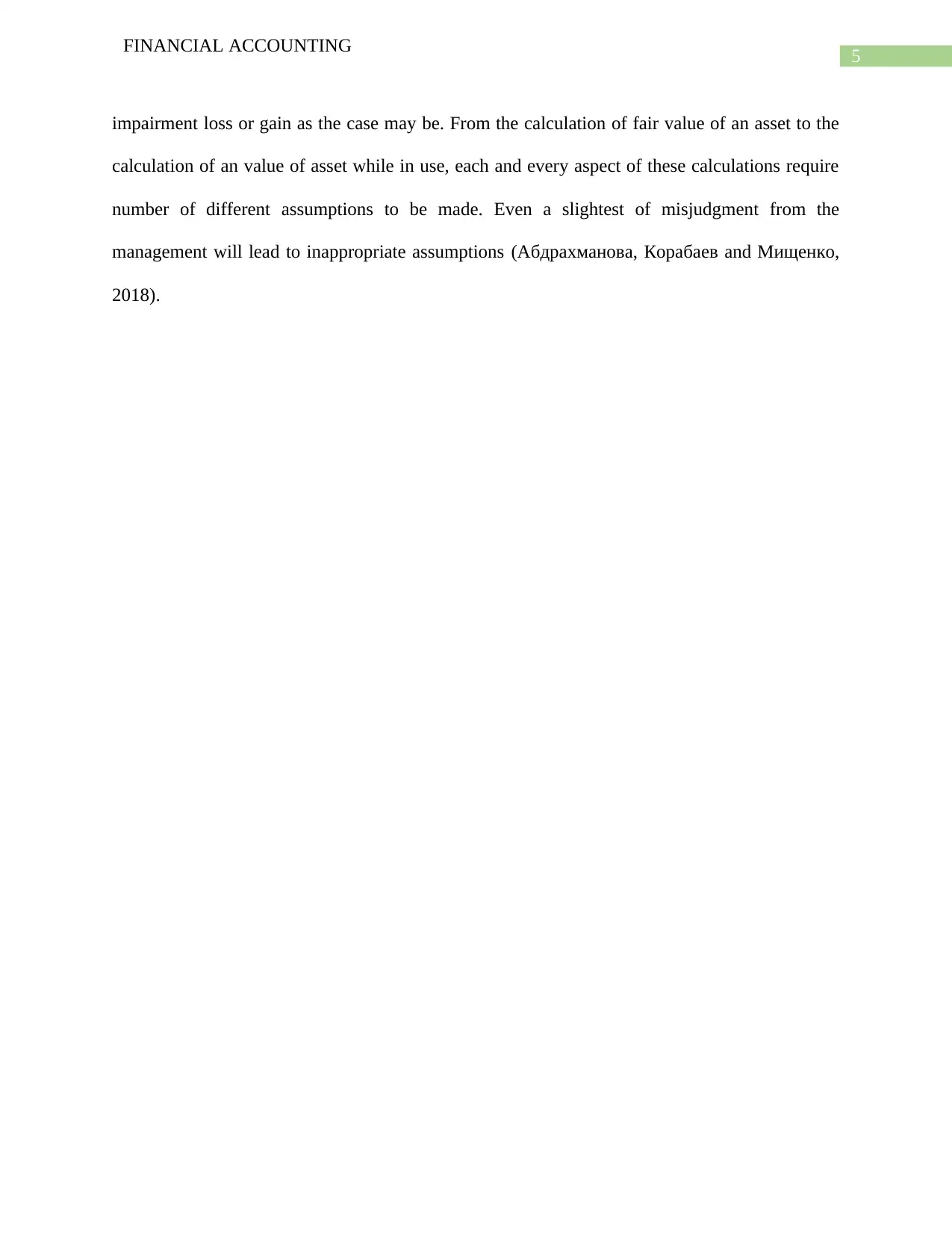
5
FINANCIAL ACCOUNTING
impairment loss or gain as the case may be. From the calculation of fair value of an asset to the
calculation of an value of asset while in use, each and every aspect of these calculations require
number of different assumptions to be made. Even a slightest of misjudgment from the
management will lead to inappropriate assumptions (Абдрахманова, Корабаев and Мищенко,
2018).
FINANCIAL ACCOUNTING
impairment loss or gain as the case may be. From the calculation of fair value of an asset to the
calculation of an value of asset while in use, each and every aspect of these calculations require
number of different assumptions to be made. Even a slightest of misjudgment from the
management will lead to inappropriate assumptions (Абдрахманова, Корабаев and Мищенко,
2018).
⊘ This is a preview!⊘
Do you want full access?
Subscribe today to unlock all pages.

Trusted by 1+ million students worldwide
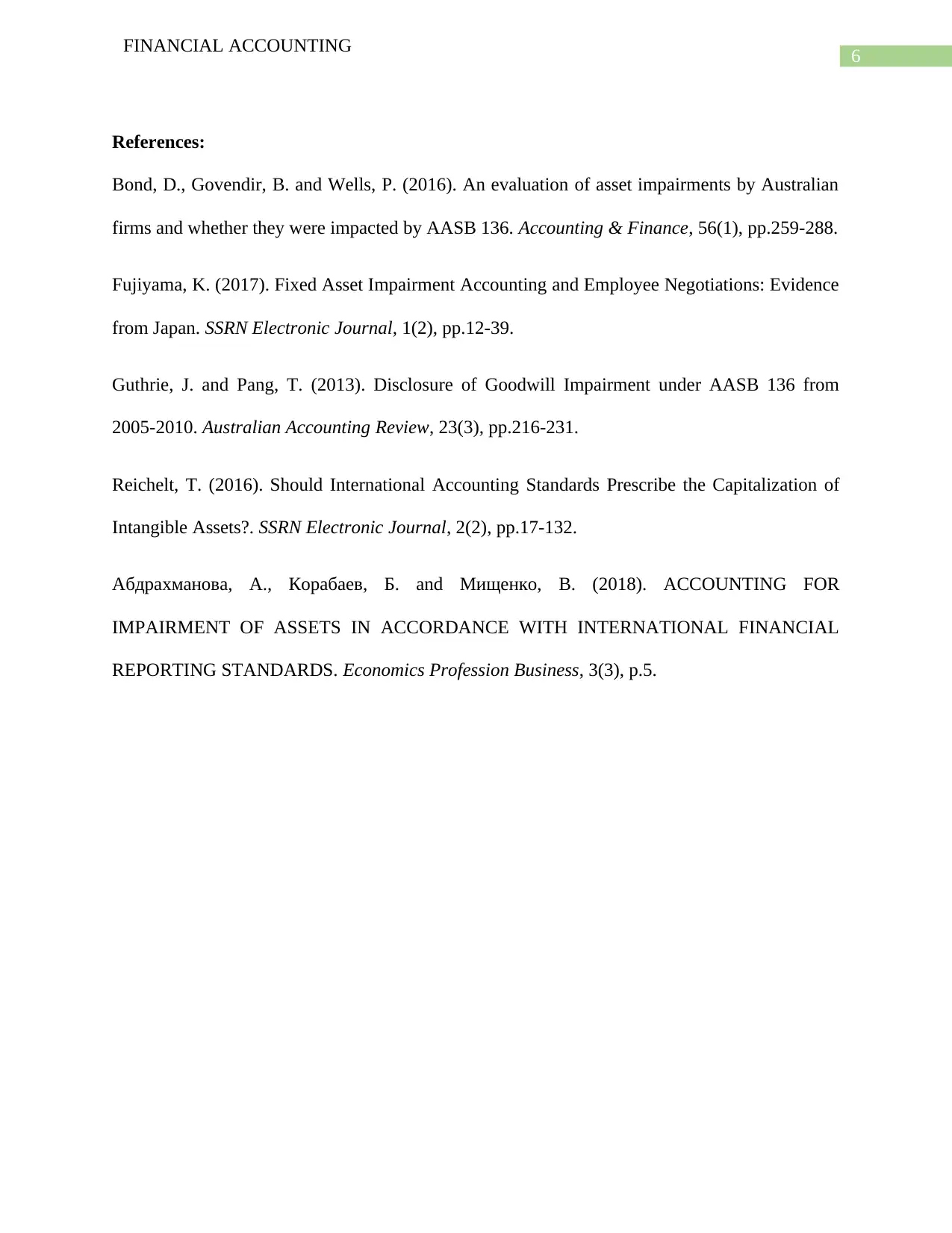
6
FINANCIAL ACCOUNTING
References:
Bond, D., Govendir, B. and Wells, P. (2016). An evaluation of asset impairments by Australian
firms and whether they were impacted by AASB 136. Accounting & Finance, 56(1), pp.259-288.
Fujiyama, K. (2017). Fixed Asset Impairment Accounting and Employee Negotiations: Evidence
from Japan. SSRN Electronic Journal, 1(2), pp.12-39.
Guthrie, J. and Pang, T. (2013). Disclosure of Goodwill Impairment under AASB 136 from
2005-2010. Australian Accounting Review, 23(3), pp.216-231.
Reichelt, T. (2016). Should International Accounting Standards Prescribe the Capitalization of
Intangible Assets?. SSRN Electronic Journal, 2(2), pp.17-132.
Абдрахманова, А., Корабаев, Б. and Мищенко, В. (2018). ACCOUNTING FOR
IMPAIRMENT OF ASSETS IN ACCORDANCE WITH INTERNATIONAL FINANCIAL
REPORTING STANDARDS. Economics Profession Business, 3(3), p.5.
FINANCIAL ACCOUNTING
References:
Bond, D., Govendir, B. and Wells, P. (2016). An evaluation of asset impairments by Australian
firms and whether they were impacted by AASB 136. Accounting & Finance, 56(1), pp.259-288.
Fujiyama, K. (2017). Fixed Asset Impairment Accounting and Employee Negotiations: Evidence
from Japan. SSRN Electronic Journal, 1(2), pp.12-39.
Guthrie, J. and Pang, T. (2013). Disclosure of Goodwill Impairment under AASB 136 from
2005-2010. Australian Accounting Review, 23(3), pp.216-231.
Reichelt, T. (2016). Should International Accounting Standards Prescribe the Capitalization of
Intangible Assets?. SSRN Electronic Journal, 2(2), pp.17-132.
Абдрахманова, А., Корабаев, Б. and Мищенко, В. (2018). ACCOUNTING FOR
IMPAIRMENT OF ASSETS IN ACCORDANCE WITH INTERNATIONAL FINANCIAL
REPORTING STANDARDS. Economics Profession Business, 3(3), p.5.
1 out of 7
Related Documents
Your All-in-One AI-Powered Toolkit for Academic Success.
+13062052269
info@desklib.com
Available 24*7 on WhatsApp / Email
![[object Object]](/_next/static/media/star-bottom.7253800d.svg)
Unlock your academic potential
Copyright © 2020–2025 A2Z Services. All Rights Reserved. Developed and managed by ZUCOL.



